
19 minute read
Do Patient Characteristics Affect Appointment No-Show Rates?
Irene J. Ganahl1† and Kim Kovalick²
¹Geisinger Commonwealth School of Medicine, Scranton, PA 18509 ²Geisinger South Wilkes-Barre, Wilkes-Barre, PA 18765 †Doctor of Medicine Program Correspondence: iganahl@som.geisinger.edu
Abstract
It is essential to ensure patients consistently show up for their appointments to fulfill primary care’s goal of continuity of care and appropriate care of the community they serve, i.e., population health. This study investigates why some Geisinger patients are unable to make their appointments, and what characteristics of the patient population contribute to the no-show rate. A total of 262 patients identified as a “no-show” for their appointment during a 30-day period were contacted via phone and asked why they were unable to make their appointment. Patient data for consenting patients (n=103) were collected via Epic, an electronic health record server. The most common reasons for missed appointments were forgetting, transportation, work, and forgetting due to life circumstances. Among those patients who consented to participate, most identified as female, single, and White (n=41) or Black (n=32); and most had Geisinger Health Plan insurance or elapsed insurance status. The most common missed appointments were morning appointments (from 8–11:59 a.m.). Patients who miss appointments are often forgotten by, or “lost” within the healthcare system. Important care gaps can be identified via follow-up with patients who miss appointments and can lead to initiatives that ultimately improve healthcare access.
Introduction
When you think of a “doctor,” what comes to mind? Maybe you think of Meredith Grey from the popular TV show Grey’s Anatomy. Maybe you think of the surgeon who performed your appendectomy a year ago. For many, the classic picture of a doctor is their primary care physician (PCP) — the dependable physician whom you can see once a year or more often, when needed, who asks about how you have been feeling; does a complete physical exam, including listening to your heart and lungs; reviews your medications; educates you about preventive testing that may be due; and remembers that the last time you saw them, you had just gotten a dog. There is a reason why PCPs fit the classic description of a doctor. It is because primary care is the foundation of medicine. In the United States, there are more than 135 medical specialties and subspecialties (1). Out of the 860.4 million physician office visits made in 2018, 51.2% of those visits were to primary care (2).
What is primary care? And if there are so many specialties in the healthcare system, why is primary care necessary? The World Health Organization (WHO) defines primary care as a “whole-of-society” approach which aims to serve all people throughout their lifetime in all aspects of health, including not just physical health, but social and mental health as well (3). While family medicine used to be the main primary care specialty, specialties such as general internal medicine, general pediatrics, adolescent medicine, and geriatric medicine are now included (4). Primary care serves as a patient’s entry point into health care (5). A patient, regardless of if they have a specific health concern or not, can see their PCP, who can then address and track the patient’s health, provide preventive healthcare such as screenings and vaccines, and refer the patient to other specialties. Essentially, if health care were a wheel, the PCP sits at the hub of the wheel with the patient and serves as the patient’s home base for health services. If the patient requires more specialized treatment, specialty physicians, sitting at the spokes of the wheel, can be utilized. The importance of primary care has been recognized and well documented. The WHO’s Alma-Ata Declaration of 1978 identified primary healthcare as an essential component of achieving the WHO’s goal of “Healthcare for All” (6). In this declaration, the WHO called for government, both national and local, to formulate and enact plans to support and strengthen primary care (6). More recently, access to primary care was noted as an essential component of the Healthy People 2030 goals under the “Health Care Access and Quality” domain (7). The WHO has even deemed primary care as “the most efficient and effective way to achieve health for all” (3). Primary care utilization has been associated with decreased hospitalizations and emergency room use, as well as better health outcomes and lower health care cost (8). Furthermore, effective primary care has been shown to increase health equity (8–9).
Despite the well-documented and supported importance of primary healthcare, total number of visits to PCPs is falling and the number of adults with no PCP visits is rising (10). Additionally, in 2020 more than 80 million American lived in a primary care health professional shortage area (HPSA), with almost 40% of those 80 million Americans residing in rural areas (11). These trends make it essential to examine where the efforts to support primary care are lacking and what more can be done to bring what has been documented as a positive force on people’s health to more people. Effective primary care requires consistent longitudinal care. This allows providers and patients to develop relationships over time (12). An essential component of providing consistent longitudinal care is ensuring patients come to their appointments. When patients are unable to make their appointments, the purpose and benefits of primary care are disrupted (13). For this reason, it is essential to identify and address reasons why a patient may not be able to make their appointments so that the benefits of primary care can be reaped. While some appointments are canceled ahead of time, others result in a no-show. This is when a patient does not come to their appointment without canceling ahead of time. This research will focus on elucidating the barriers to healthcare that the patients of Geisinger South Wilkes-Barre (SWB) Primary Care face through investigating the reasons why patients miss appointments.
Geisinger SWB Primary Care is an outpatient primary care residency clinic in northeastern Pennsylvania, a state where most counties have been identified as primary care HPSAs (11). This clinic has been identified as having a high no-show rate of 21%, compared to the Geisinger systemwide no-show rate goal of less than 5%. For this reason, patients from Geisinger SWB Primary Care were contacted as participants for this research. Located in south Wilkes-Barre in Luzerne County, Geisinger SWB serves patients from across northeastern Pennsylvania. Luzerne County has a population of 326,053 over 890 square miles (14). In addition to being a county identified as having a primary care HPSA, the median income is $53,194, compared to the United States median income of $64,944, and 15.1% of the population is under the poverty level, compared to 11.4% across the United States (14). Additionally, 20.2% of the population is over the age of 65, compared to 16.5% across the United States (14). These statistics represent barriers to healthcare that identify Luzerne County as a place where effective primary care could have a positive impact on its citizens. As part of the Geisinger system, patients of Geisinger SWB have access to PCPs, a pharmacist, Geisinger at Home services, case managers, a behavioral case manager, and community health assistants. Geisinger is committed to primary care and has made efforts to reduce the primary care shortage by implementing the Abigail Geisinger Scholars program at the Geisinger Commonwealth School of Medicine, a program which rewards students who decide to pursue a career in primary care by forgiving a year’s worth of tuition for every year the student returns to Geisinger to work post-residency. Quality of care can be assessed through a variety of factors such as clinical quality and insurance coverage (8). And while research has been conducted to investigate barriers to healthcare, much of this research has focused on variables that can be quantified such as wait times and demographics of the patient population. Furthermore, very little research has focused directly on contacting patients who have missed appointments and interviewing them due to the time-intensive nature of this type of research and the little time busy primary care offices must devote to this type of research. Given the nature and ultimate goal of primary care, patient-centered quality measures should be utilized (8). This research is part of the vanguard of new research that focuses on patient-centered quality measures rather than disease-specific ones.
This research asked the question “Are there patient characteristics that are common among patients who no-show at the Geisinger SWB Primary Care clinic?” The research additionally asks “Why do patients miss their appointments?” The goal of this descriptive study was to gain an understanding of why patients are unable to make their appointments and identify potential barriers to primary healthcare access in order to provide concrete and actionable ways to improve health care delivery services. The data will be used to direct future initiatives to better help patients access the quality health care they deserve. Institutional Review Board (IRB) approval was attained before the data collection process and can be referenced via IRB approval number 2021-0444. The study was conducted in accordance with the relevant guidelines and regulations outlined by the IRB.
Methods
Data was collected from appointments scheduled at Geisinger SWB Primary Care between June 21, 2021, and July 21, 2021. Participants over the age of 18 years old who missed their appointment during this time were contacted for participation, and data from consenting patients were collected for this research. The data collection was two-fold and included data collected from phone interviews with patients and data from an electronic health record system, Epic.
Phone interviews
Patients who were over the age of 18 and had missed their appointment during the data collection period, were identified using the Epic scheduling tool and called by a researcher. If the patient answered the phone, a script, which was approved by the Internal Review Board, was read. After being introduced to the study, patients had the opportunity to consent to or decline participating in the study. Consenting patients were then asked about why they were unable to make their appointment, and these responses were recorded in a spreadsheet and coded into categories (i.e., work, transportation, childcare). Along with the coded response, a brief description of the response was recorded to verify correct category placement with another researcher. Participants who did not answer the first call were called back once. If they consented to participate, their answers and data were included, and if they denied or did not answer the second call, they were not included. To preserve patient privacy, no voice mails were left and information about the reason for the call was only given to the patient themselves and not to any other person who answered the call. During the fourth week of the study, the researchers gained access to a Language Line card, and at this point patients who did not speak English as their primary language were contacted and consenting participants were included. In these instances, all communication occurred via a trained medical interpreter. At the end of the call, each participant was asked if they would like the appointment rescheduled. Patients who wanted to reschedule their appointments were forwarded to the front desk staff or to the clinic manager, who then reached out to the patient. If the patient identified transportation as a barrier to healthcare, the researcher provided resources, found using Neighborly, depending on the patient’s needs (15).
A form was completed for each participant called, whether they consented to participate or not, which included the date of the calls and a brief description of the conversation. These forms were subsequently scanned into the patient’s chart to record any communication with a patient, to be used as a reference in case the patient called back with questions, and to ensure proper follow-up if needed. This follow-up included referral to case manager or physician and appointment rescheduling.
Epic
Data regarding appointments during the data collection period was collected via Epic. This process included first going back through the clinic’s schedule via Epic and identifying missed appointments. Once a missed appointment was identified,
information regarding the appointment, also collected via Epic, was recorded in Excel. • Total number of appointments (both adult and child) • Total number of no-shows (both adult and child) • Day of the week of appointments and no-shows • Nurse appointments and no-shows • Pharmacist appointments and no-shows • Time of day of no-shows (separated into early morning, 8–9:59 a.m.; late morning, 10–11:59 a.m.; early afternoon, 12–1:59 p.m.; late afternoon, 2–4 p.m.)
Additional information was collected from consenting participants from patient charts via Epic. All information was deidentified and recorded in Excel.
• Age • Behavioral case manager status • Case manager status • Distance in miles from SWB clinic • Doctor for appointment • Gender • Insurance type • Language • Living situation (i.e., married, single, divorced) • MyGeisinger use • No-show rate (at SWB and at all other facilities) • Race • Seeing a different doctor from their primary care physician This data was recorded in a spreadsheet and secured on password-protected computers in the SWB clinic.
Analysis
The goal of this study was to answer the question “Who is missing their appointments?” Therefore, a descriptive analysis was used to identify if certain characteristics were more common among patients who no-show.
Results
Over the data collection period, there were 294 missed appointments out of 1,363 total appointments. This demonstrated a no-show rate of 22% (Table 1). Two hundred sixty-two patients who had missed their appointments and met the eligibility requirements were contacted. Of those 262 patients, 103 consented to participate. Most of the missed appointments were return appointments, scheduled for Monday, and in the late morning (Figures 1, 2, 3).
Demographics
The sample was primarily female, English-speaking, white, and single (Figures 4, 5, 6, 7).
Telephone interview
The most common reasons for missed appointments were forgetting the appointment, transportation, and conflicts with work (Figure 8).
Other patient information
The most common insurance plan among the sample was Geisinger Health Plan Family insurance (Figure 9). Additionally, more than half of the patients who missed appointments were

Table 1. Appointments and no-shows during the data collection period
Table 2. Missed appointments by MyGeisinger use, distance from SWB clinic, PCP, case manager status, and days from schedule to appointment
Figure 1. Missed appointments by appointment type

Appointment type
scheduled to see a physician that was not their primary care physician (Table 2). Most patients had access to MyGeisinger, a patient portal (Table 2). The average distance from the clinic was 4.34 (5.55) miles (Table 2). Very few patients had a behavioral or nurse case manager (Table 2).
Conclusion
This research found that at the Geisinger SWB facility, patients who missed appointments were primarily female, Englishspeaking, white, and single; and that most missed appointments occurred on Mondays. Other research has also demonstrated non-married patients to be at a higher rate of no-show and higher no-show rates on Monday (17). However, our data is not consistent with research that has shown male patients and patients of ethnic minorities to be more likely to no-show (17). These findings warrant future research into why these discrepancies exist.
Day of week Time of day

Figure 2. Missed appointments averaged by day of the week.
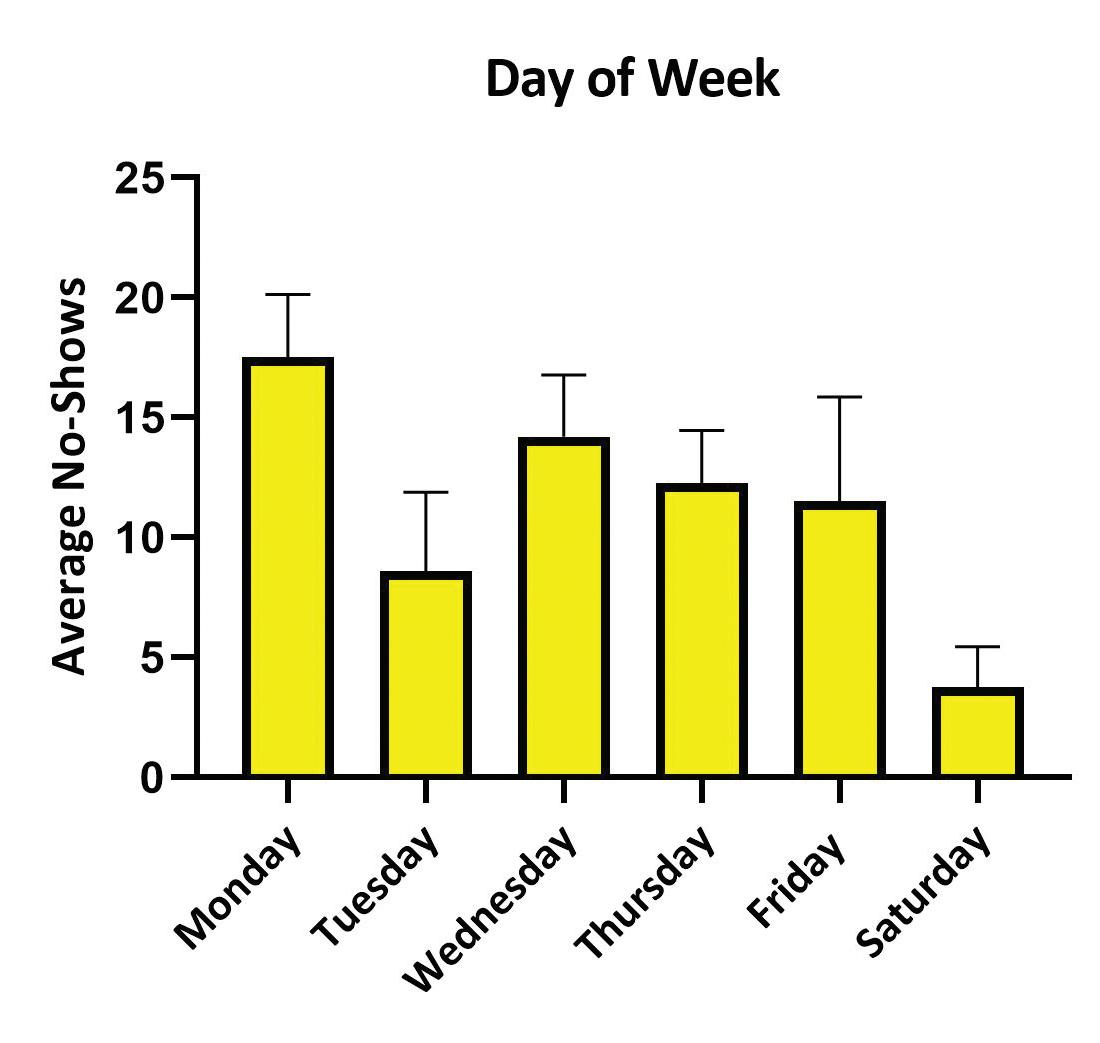
Gender identification
Figure 3. Missed appointments by time of day.
Language Race
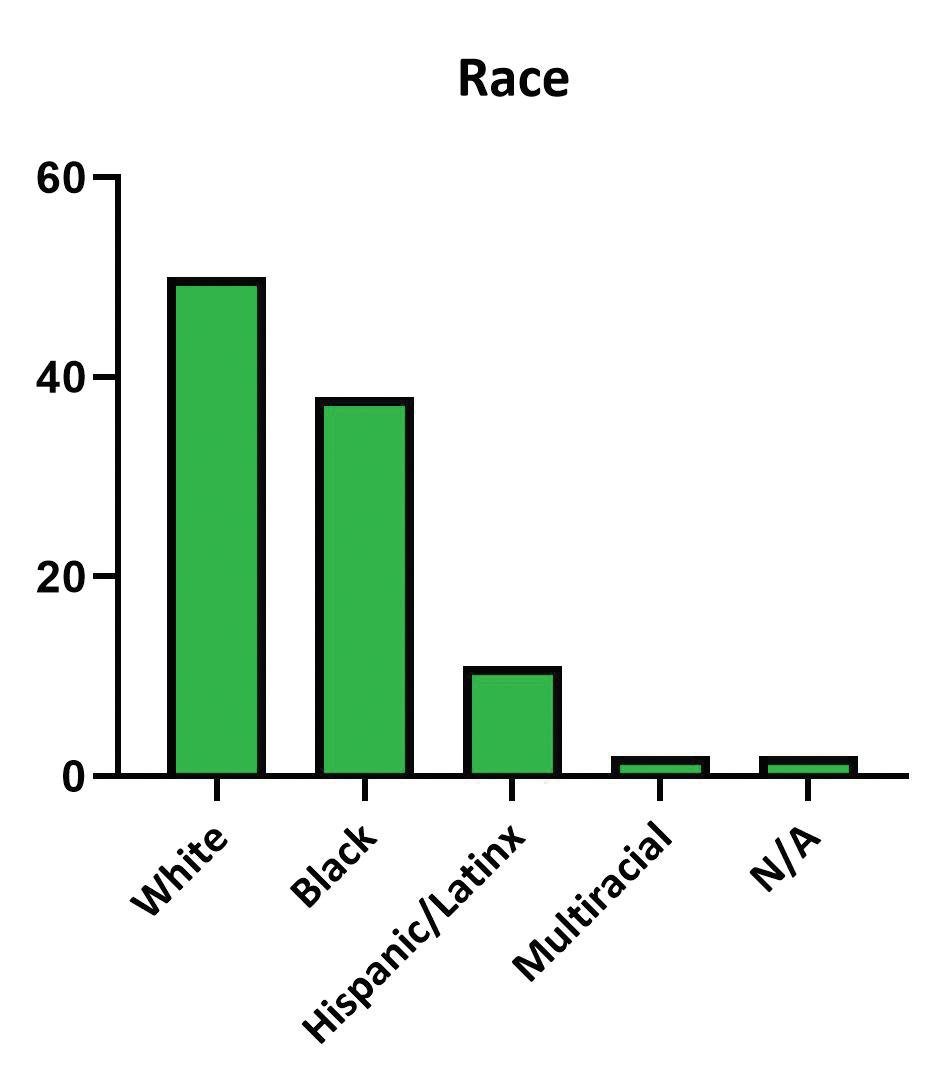

Figure 4. Missed appointments by gender Figure 5. Missed appointments by language Figure 6. Missed appointments by race
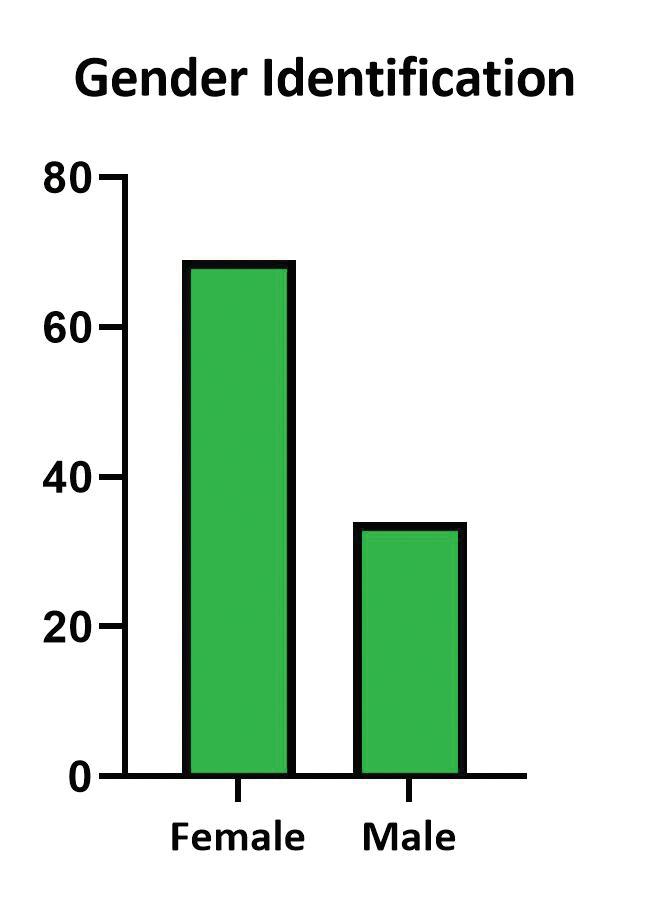
This research investigated why Geisinger SWB patients were unable to make their appointments. Specifically, the research asked if there are characteristics that are common among patients who no-show. Twenty-three variables were examined to identify barriers to health care this patient population faces. The data suggests several methods that could improve patient access to primary care and identifies specific patients that could benefit the most from these efforts. The effectiveness of these recommendations should be investigated in future research. Efforts to improve the no-show rate should include patient education and transportation assistance. Patient education should focus on the importance of primary care and preventive medicine. During the telephone interview, some patients reported they did not want to be seen by residents, as they were not “real doctors.” As Geisinger SWB is a resident clinic, education regarding the qualifications of residents and their role in the health care team is imperative. Additionally, patients who chronically no-show should be educated on the effects of missing appointments, as the literature has determined a previous history of missing appointments to be associated with missing appointments in the future (17). Patient education is already being put into action by on-site access teams and should be continued. Additionally, transportation assistance should be included in improvement efforts. Patients should be asked about their transportation status to identify patients who could benefit from transportation resources such as the Senior Lottery Program, Luzerne County Transportation Authority Medical

Figure 7. Missed appointments by relationship status Figure 8. Reasons for missed appointments
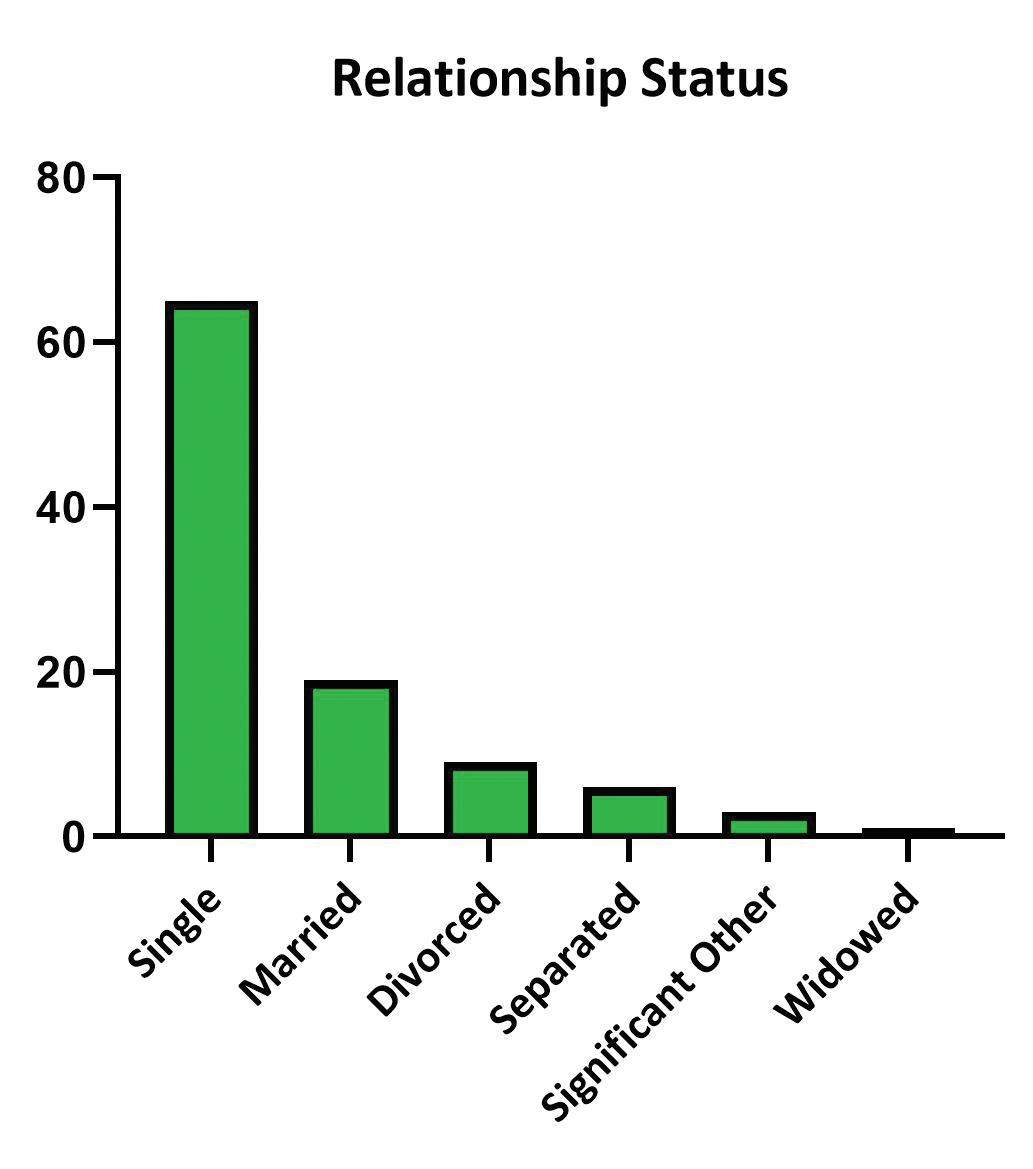
Insurance type
Figure 9. Missed appointments by insurance coverage
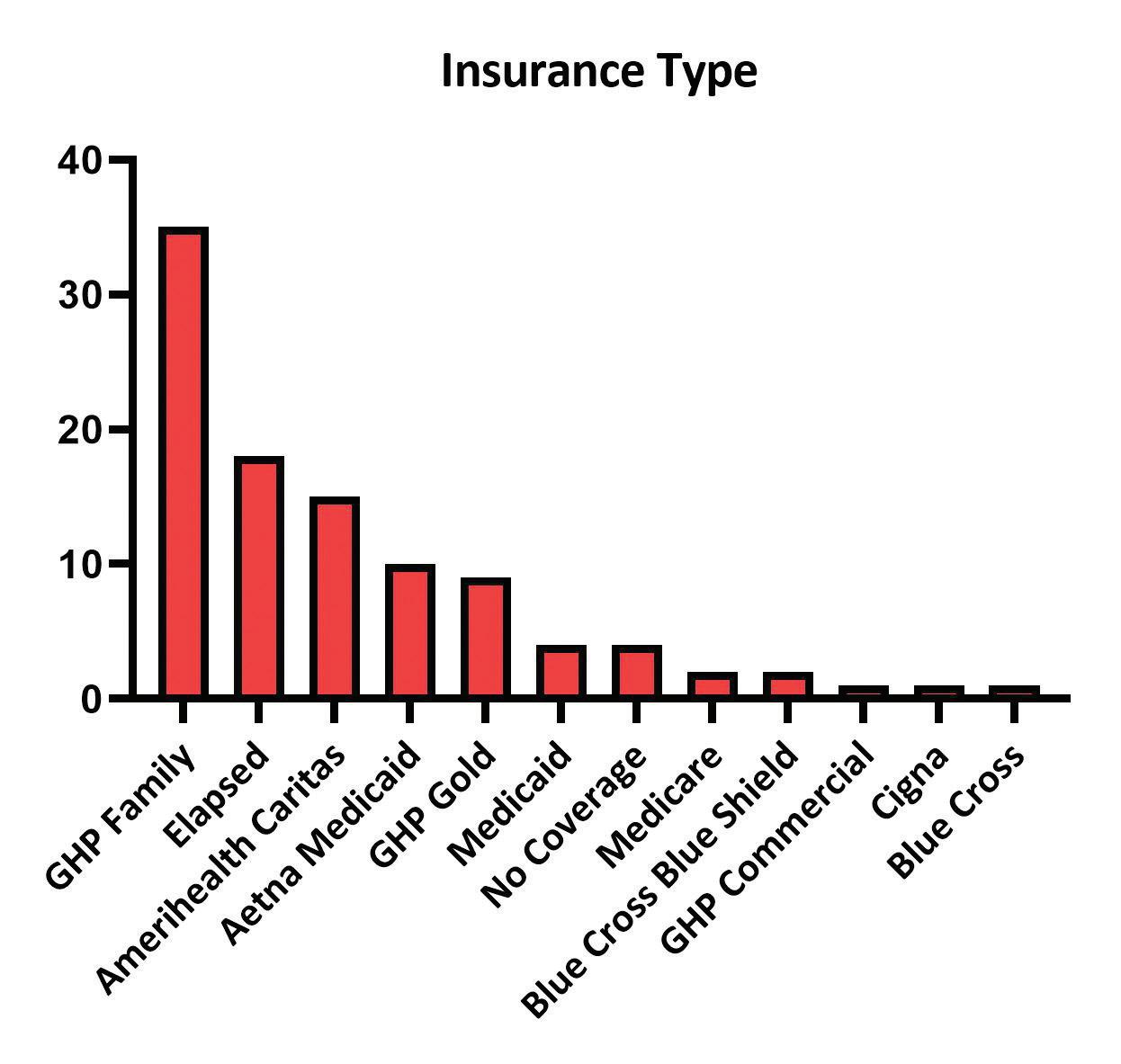
Assistance Transportation, and Neighborly. Nurse case managers should also be utilized as a resource, as they have the best knowledge of available transportation assistance programs. These recommendations should be focused toward patients that this research has identified as “at a high risk” for missing appointments. These would be patients who identify as female and live alone. Additionally, patients with Geisinger Health Plan Family insurance were identified as missing the most appointments compared to other insurance plans. Because this clinic is a Geisinger facility, this suggests a potential for an incentive plan in which patients with GHP Family insurance are rewarded for making their appointments. This would lead to less no-shows and better health care for patients. This research identified many important care gaps. However, as the first research of this type conducted at this clinic, there were limitations that should inform future work in this subject. First, there were many variables that would be important to examine, however, there was insufficient data in Epic. Examples of these variables included education level, employment status, food insecurity, financial resource strain, and sexual orientation. Additionally, due to the constraints of the IRB approved for this study, the data analysis was unable to link variables to each other for risk of including identifiable information. Therefore, future research should include this type of data analysis. Future research should also focus on comparing data from patients who miss appointments to patients who make their appointments, to more clearly elucidate the characteristics of patients who no-show. One of the challenges faced during the data collection process was time. Each call, including follow-up, when necessary, took a significant amount of time. Additionally, data collected via Epic was collected by manual chart review. Primary care offices are very busy and lack the time required to complete this type of research. Therefore, without a dedicated researcher, this research would be difficult to carry out.
Perhaps the most striking finding of this research is the importance of patient follow-up. Of the 103 participants, 55 (53%) requested a rescheduled appointment. And of those 55, 26 (25%) appointments were rescheduled during the data collection period. Following up with patients who miss appointments is an important strategy to make up lost appointments. An additional importance of follow-up was made clear through speaking with patients. During the data collection period, researchers spoke to a patient who was in acute distress and transferred to their physician for care. Another patient was identified as moved to a nursing home. Patients were referred to their case managers or to their physicians and received resources for transportation. What would have happened to these patients had no one called? Through following up with
patients who miss appointments, especially through phone calls, clinics can get a better understanding of the patient population they serve and care for patients who may have otherwise been lost in the system. Additionally, this type of research has the added benefit of making patients feel heard and giving them a voice in their care. The number of medical students choosing to specialize in primary care is declining and it is expected that by 2033 there will be a shortage of PCPs (16). While this shortage will be felt by everyone, it will be especially detrimental for rural populations. This makes addressing the findings of this research even more imperative. It will be essential to address the actionable items suggested in this paper to not only improve the number of patients utilizing primary care, but to improve how patients are utilizing primary care.
Acknowledgments
The authors would like to acknowledge John Jurosky, clinic site manager at Geisinger SWB Primary Care, as well as the providers and staff at Geisinger Primary Care SWB: Colleena Jenceleski (case manager), Dr. Elise Mester, Jamela James (front desk), Jennifer Antall (community health assistant), Kathleen Coyle (Geisinger at Home), Kathleen Pedley (nurse), Katrina O’Day-Berish (behavioral health case manager), Theresa Shrader (nurse), Shantese Wilson Ward (front desk), and Dr. William Barker.
Disclosures
The authors have no disclosures. Funding for the research was part of the Geisinger Commonwealth School of Medicine Summer Research Immersion Program.
References
1. AAMC. Specialty profiles [Internet]. Careers in Medicine; 2022 [cited 2022 April 24]. Available from: https://www.aamc.org/cim/explore-options/specialtyprofiles#:~:text=Begin%20your%20specialty%20 exploration%20by,nearly%2040%20specialties%20in%20
Canada. 2. Santo L, Okeyode T. National Ambulatory Medical Care Survey: 2018 National Summary Tables. Available from: https://www.cdc.gov/nchs/data/ahcd/namcs_summary/ 2018-namcs-web-tables-508.pdf.
3. WHO. Primary health care [Internet]. World Health Organization; 2022. [cited 2022 April 24]. Available from: https://www.who.int/health-topics/primary-healthcare#tab=tab_1.
4. Dalen JE, Ryan KJ, Alpert JS. Where have the generalists gone? They became specialists, then subspecialists. The American Journal of Medicine. 2017;130(7):766–768.
5. AAFP. Primary care [Internet]. American Academy of Family Physicians; 2022. [cited 2022, April 24]. Available from: https://www.aafp.org/about/policies/all/primarycare.html. 6. International Conference on Primary Health Care. Declaration of Alma-Ata. WHO Chron. 1978 Nov;32(11):428-30. Available from: https://cdn.who. int/media/docs/default-source/documents/almaatadeclaration-en.pdf?sfvrsn=7b3c2167_2.
7. Healthy People 2030. Access to primary care [Internet]. U.S Department of Health and Human Services, ODPHP; 2022. [cited 2022 April 24]. Available from: https://health. gov/healthypeople/priority-areas/social-determinantshealth/literature-summaries/access-primary-care. 8. Shi L. The impact of primary care: a focused review. Scientifica (Cairo). 2012;2012:22 p.
9. Starfield B, Shi L, Macinko, J. Contribution of Primary Care to Health Systems and Health. Milbank Q. 2005 Oct 03; 83:457-502.
10. Ganguli I, Shi Z, Orav EJ, Rao A, Ray KN, Mehrotra A.
Declining use of primary care among commercially insured adults in the United States, 2008–2016. Ann Intern Med. 2020;172(4):240–247.
11. HRSA. Shortage areas [Internet]. 2020. [cited 2022 April 24]. Available from: https://data.hrsa.gov/topics/healthworkforce/shortage-areas. 12. O’Neill B, Ferrer R, O’Brien P, Watt G, Gottlieb L, Pinto A, et al. Improving equity through primary care: Proceedings of the 2019 Toronto International Conference on Quality in
Primary Care. Ann Fam Med. 2020 Jul;18(4):364-369.
13. Kaplan-Lewis E, Percac-Lima S. No-Show to primary care appointments: Why patients do not come. J Prim Care & Community Health. 2013 October;251-255.
14. US Census Bureau. QuickFacts: United States; Luzerne County [Internet]. 2021. [cited 2022 April 24]. Available from: https://www.census.gov/quickfacts/fact/table/
US,luzernecountypennsylvania/PST045221. 15. Neighborly. https://www.neighborlypa.org/. 16. AAMC. The Complexities of Physician Supply and Demand: Projections From 2018 to 2033. [Internet]. June 2020. Available from: https://www.aamc.org/system/ files/2020-06/stratcomm-aamc-physician-workforceprojections-june-2020.pdf 17. Dantas LF, Fleck, JL, Cyrino Oliveira FL, Hamacher, S. Noshows in appointment scheduling – a systematic literature review. Health Policy. 2018 April;122(4):412-421.









